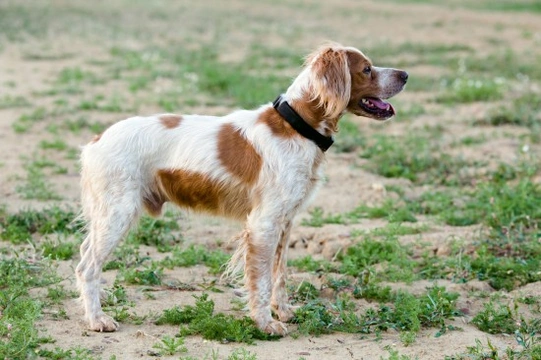
The hereditary health and conformation of the Brittany spaniel
The Brittany spaniel is a French dog breed that is mainly used as a gun dog for hunting birds, and which is also becoming more and more common as a pet. While the breed’s name includes the term “spaniel,” the Brittany spaniel does in fact share more traits with setting and pointing dogs than it does with true spaniels, with a physical appearance somewhere between the spaniel and the setter. The breed was developed in France from the 17th century onwards, and received full worldwide recognition during the 20th century.
The Brittany spaniel is a medium sized breed, with a slight variation in size and build between the French lines of the breed and their American cousins. The French lines’ average height is 17.5-20’5” tall at the withers, and they can weigh up to 20kg. They are athletic, lively dogs that have a solid build without being overly heavy, and which have a long, graceful running gait. Their coats are straight with some feathering around the legs and the underbelly, and they can be seen in a wide range of colours. Liver and white or orange and white are the most common colours for the breed, but orange roan, liver roan and tricolour are also permitted.
If you are considering buying a Brittany spaniel, it is of course important to familiarise yourself with all of the core traits of the breed, including their hereditary health and any issues with their conformation. In this article, we will look at the average longevity, hereditary health and conformation of the Brittany spaniel in more detail. Read on to learn more.
Average longevity of the Brittany spaniel
The Brittany spaniel is widely considered to be a healthy, robust dog that is hardy and not prone to developing minor ills. The median lifespan of the breed within the UK is 12 years, 11 months, with around one in five dogs living to 14-15 years old.
Brittany spaniel conformation concerns
The Brittany spaniel is considered to be a well-balanced dog that is not plagued with problems caused by the exaggeration of any of their conformation traits. One thing that all Brittany spaniel owners should be aware of, however, is that the long ears of the dog should be regularly cleaned and dried, as they are apt to pick up dirt and debris that can work their way into the ear canal, and which may cause irritations and infections.
Hereditary health and genetic diversity
The coefficient of inbreeding statistical average for the breed is 5.8%, which is low enough to not generally be considered as of concern. Breeders of the Brittany spaniel should assess the coefficient of inbreeding figure for their parent dogs carefully, to ensure that the figure remains low.
The British Veterinary Association recommends hip score testing for parent dogs, as around 10% of dogs of the breed as a whole are statistically likely to develop hip dysplasia. The breed’s mean hip score is 17, which is relatively high, and breeding dogs should score below 17 to be considered as viable parents.
Elbow dysplasia is also somewhat prevalent within the breed, and elbow score testing is also recommended, with the ideal score being zero.
Epilepsy is also found within the breed, although no definitive pre-breeding test is available to identify a propensity to the condition in litters born to healthy parents. Brittany spaniel owners with epileptic dogs are encouraged to contribute a sample of their dog’s DNA to an ongoing project on the health of the breed, managed by the UC Davies Veterinary Genetics Laboratory.
Finally, the breed is also classed as one that has an elevated predisposition to canine discoid lupus erythematosus.
Known health problems within the breed as a whole
As well as the issues mentioned above that are known to have a hereditary factor to them, the Brittany spaniel is also listed as being potentially prone to a small number of other health problems with a reasonable rate of occurrence. These conditions include:
- Various different types of eye disorders, including multi-focal retinal dysplasia, simple glaucoma, and cataracts, although cataracts generally occur in later life.
- Various different types of cancers are found within the breed, with cancer being given as one of the main causes of death in the breed in maturity. Some of the most commonly occurring cancers include perianal gland adenomas, cutaneous melanoma, cutaneous fibrosarcoma, and cutaneous fibroma.
- Hypothyroidism, an underproduction of the necessary thyroid hormones is also found, although this can usually be managed with lifelong medication.
- Patellar luxation, a dislocation of the kneecap due to improper fixing can also occur, but this may be operable.
- Various types of skin allergies and sensitivities are also known to occur within the breed.
- Spinal muscular atrophy, a spinal weakness has been diagnosed within the breed, but this condition is considered to be uncommon.



